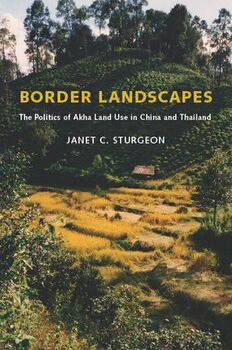
Border Landscapes: The Politics of Akha Land Use in China and Thailand (Culture, Place, and Nature) PDF
Preview Border Landscapes: The Politics of Akha Land Use in China and Thailand (Culture, Place, and Nature)
CULTURE, PLACE, AND NATURE STUDIES IN ANTHROPOLOGY AND ENVIRONMENT Devon Peña and K. Sivaramakrishnan, Series Editors CULTURE, PLACE, AND NATURE Centered in anthropology, the Culture, Place, and Nature series encompasses new interdisciplinary social science research on environmental issues, focusing on the intersection of culture, ecology, and politics in global, national, and local contexts. Contributors to the series view environmental knowledge and issues from the multiple and often conflicting perspectives of various cultural systems. The Kuhls of Kangra: Community-Managed Irrigation in the Western Himalayaby Mark Baker The Earth’s Blanket:Traditional Teachings for Sustainable Living by Nancy Turner Property and Politics in Sabah, Malaysia: Native Struggles over Land Rights by Amity A. Doolittle Border Landscapes: The Politics of Akha Land Use in China and Thailand by Janet C. Sturgeon BORDER LANDSCAPES The Politics of Akha Land Use in China and Thailand JANET C. STURGEON UNIVERSITY OF WASHINGTON PRESS Seattle and London THIS PUBLICATION WAS SUPPORTED IN PART BY THE DONALD R. ELLEGOOD INTERNATIONAL PUBLICATIONS ENDOWMENT. Copyright © 2005 University ofWashington Press Printed in the United States ofAmerica 12 11 10 09 08 07 06 05 5 4 3 2 1 Material drawn from chapter 4 was first published in “Border Practices, Boundaries and the Control ofResource Access: A Case Study from China, Thailand and Burma,” Development and Change35, no. 3 (June 2004): 463–84. Material drawn from chapters 4 and 6 was first published in “Post-Socialist Property Rights for Akha in China,” Conservation and Society2, no. 1 (January-June 2004): 137–61. All rights reserved. No part ofthis publication may be reproduced or transmitted in any form or by any means, electronic or mechanical, including photocopy, recording, or any information storage or retrieval system, without permission in writing from the publisher. University ofWashington Press PO Box 50096, Seattle, WA 98145, U.S.A. www.washington.edu/uwpress Library ofCongress Cataloging-in-Publication Data can be found at the back ofthis book. The paper used in this publication is acid-free and 90 percent recycled from at least 50 percent post-consumer waste. It meets the minimum requirements ofAmerican National Standard for Information Sciences—Permanence ofPaper for Printed Library Materials, ansi z39.48–1984. 8A For my parents, Anna and Galen Sturgeon CONTENTS ACKNOWLEDGMENTS ix Introduction 3 1 The Production ofBorder Landscapes 24 2 The Production ofMarginal Peoples and Landscapes: Resource Access on the Periphery 42 3 The Production ofBorders: Sites for the Accumulation and Distribution ofResources 65 4 Small Border Chiefs and Resource Control, 1910 to 1997 80 5 Premodern Border Landscapes under Border Principalities 119 6 Landscape Plasticity versus Landscapes ofProductivity and Rule: Akha Livelihoods under Nation-States 142 Conclusion 201 APPENDIX 1 Trees and Shrubs ofMengsong, China 209 APPENDIX 2 Trees and Shrubs ofAkhapu, Thailand 217 NOTES 221 GLOSSARY 229 BIBLIOGRAPHY 233 INDEX 245 ACKNOWLEDGMENTS IN CONSIDERING MY DEBTS, MY DEEPEST THANKS GO TO THE AKHA VIL- lagers in Xianfeng (China) and Akhapu (Thailand) who submitted patiently to hours of interviews, treks through their land, and repeat conversations on complicated issues. Their tenacity and intelligence inspired this book. Xu Jianchu, then deputy director ofthe ethnobotany department ofthe Kunming Institute ofBotany (KIB), served as host for my research in China. Beginning in the late 1950s, researchers at KIB carried out pathbreaking eth- nobotanical work in Xishuangbanna. An heir to this tradition, Professor Xu moved beyond it to establish one of the first nongovernmental organiza- tions in China, the Center for Biodiversity and Indigenous Knowledge in Kunming. He also introduced me to Mengsong. Others who generously facil- itated field research in China included, among others, Long Chunlin, Su Yongge, Wang Jieru, and Liu Yitao at KIB; Zuo Ting at the Yunnan Academy ofSocial Sciences; Lu Xing and Cai Kui at the Yunnan Institute ofGeography; and Liu Hongmao of the Xishuangbanna Tropical Botanic Garden. Tao Guoda, forest taxonomist at the Botanic Garden, identified all my tree and plant species in China. My able research assistant/interpreter was Wang Jianhua (Ayu), an Akha master’s student at KIB. My host in Thailand was Chayan Vaddhanaphuti, then director of the Social Research Institute at Chiang Mai University (CMU). Ajarn Chayan, a renowned scholar/activist in Thailand, welcomed me into his lively com- munity ofresearchers and gave skillful advice on how to proceed. The most
